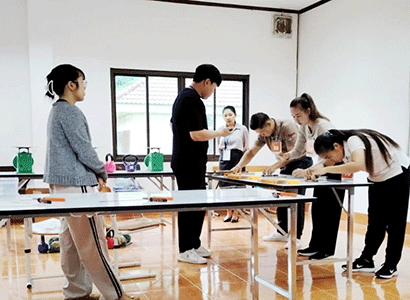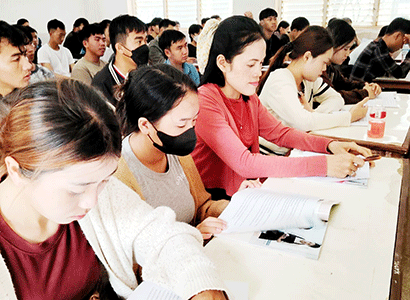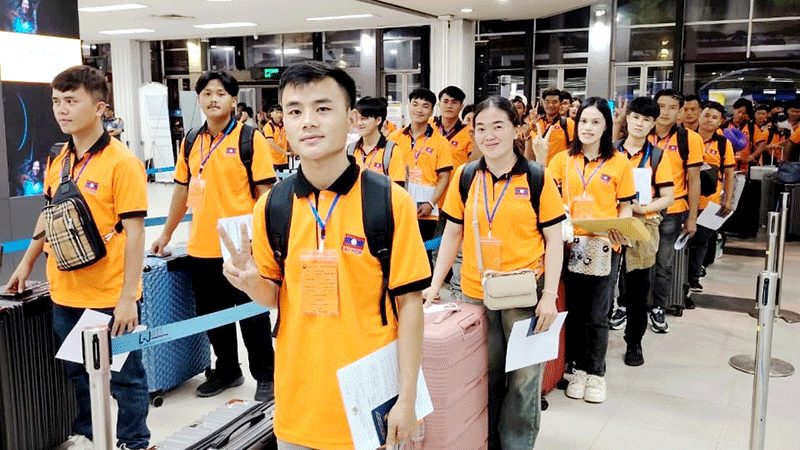 |
| Applicants prepare to take tests in the hope of securing jobs under Korea’s Employment Permit System. |
The more fences, the stronger; the more relatives, the better
The year 2025 marks the 30th anniversary of the re-establishment of diplomatic relations between the Lao People’s Democratic Republic and the Republic of Korea. Over the past three decades, cooperation has deepened in diplomacy, economics and culture. Among these, developments in people-to-people links are particularly noteworthy.
As of June 2025, about 17,000 Lao nationals were living and working in Korea—more than double the figure recorded in the same period last year. The majority are dispatched workers employed in manufacturing and agriculture.
 |
 |
| Examiners supervise candidates during the manual skills test. |
Participants attend a pre-departure training class before taking up jobs in the Republic of Korea. |
Employment opportunities for Lao workers in Korea have expanded significantly in recent years under the Employment Permit System (EPS), which enables small and medium-sized enterprises to hire foreign workers for three to five years.
In 2016, the Lao Ministry of Labour and Social Welfare signed a Memorandum of Understanding with Korea’s Ministry of Employment and Labor, opening the way for Lao nationals to take up jobs in manufacturing and farming. Since the pandemic ended, the number of new EPS entrants has continued to grow, while many Lao workers are being re-dispatched at the request of Korean employers, who value their diligence and skills.
Since 2022, short-term seasonal employment has also become an important pathway. Today, Lao seasonal workers are contributing to around 80 rural communities in Korea during peak farming seasons. Earlier this year, both governments approved the dispatch of Lao seafarers, paving the way for employment in Korea’s fisheries sector.
As labour mobility increases, there is a growing need to strengthen cooperation to ensure safe working conditions, fair treatment, and effective management of entry, residence and welfare for Lao workers.
Foreign employees often face difficulties in adapting to a new culture and language, which can heighten risks in the workplace. To address these challenges, both governments have introduced measures to safeguard workers. Lao employees receive mandatory pre-departure training covering Korean language and culture, labour laws and industrial safety.
 |
Lao workers prepare to depart for jobs in the Republic of Korea under the Employment Permit System. |
Korea’s Act on the Employment of Foreign Workers also guarantees basic rights and protection. The Ministry of Employment and Labor operates a 24-hour counselling hotline (tel: 1577-0071; press 18 for Lao) offering advice in the Lao language. HRD Korea provides interpretation services, monitors living conditions, and assists new arrivals in adjusting to life and work. Employers are required to undergo orientation on foreign worker management to better understand cultural differences and promote inclusive workplaces.
The new Korean government, inaugurated in June, has pledged to build “a society where life and safety come first”. President Lee Jae-myung has called on all sectors to ensure that no unjust discrimination or human rights violations occur against migrant workers or other vulnerable groups.
A Lao proverb says, “ຮົ້ວຫຼາຍຫຼັກຈຶ່ງໝັ້ນ ພີ່ນ້ອງຫຼາຍຊັ້ນຈຶ່ງດີ” – the more fences, the stronger they are, and the more relatives, the better. Likewise, labour cooperation is set to remain a cornerstone of the growing friendship between Laos and Korea. Looking ahead, the Lao EPS Center will continue to work closely with the Lao government, the Korean Embassy and partner institutions to ensure that labour exchanges develop in a safe, sustainable and worker-friendly way in the decades to come.
By Jiwon Baek, Laos EPS Center (HRDK)
By Advertorial Desk
(Latest Update September 8, 2025)
|





